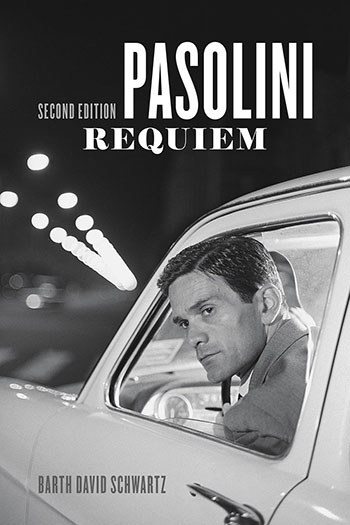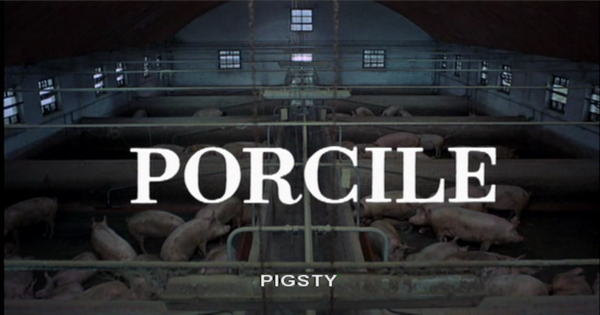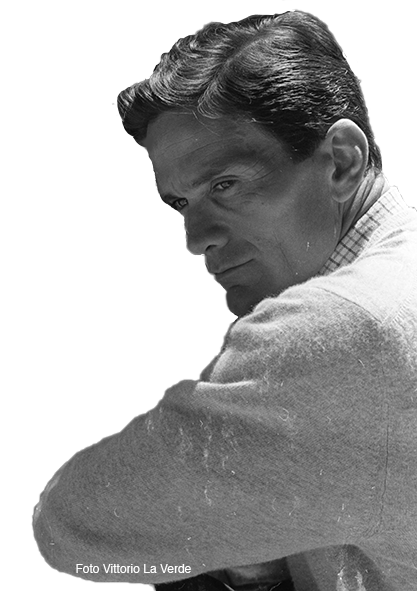La seconda edizione americana del volume di Barth David Schwartz Pasolini Requiem (Università di Chicago, 2017), un classico della bibliografia critica pasoliniana, dà modo allo studioso Jordan Penney di indagare l’opera del poeta-cineasta italiano e soprattutto di verificarne l’attualità oltre il contesto del secondo dopoguerra italiano che ne vide la fioritura.
Riprendiamo nella versione inglese le riflessioni di Penney, che sono attente al rapporto tra Pasolini e Gramsci e sottolineano in particolare la sensibilità pasoliniana verso i temi del sacro e dell’arazionale.
Weapons of Poetry and Images: On the Works of Pier Paolo Pasolini
by Jordan Penney
www.popmatters.com – 16 ottobre 2017
Barth David Schwartz covers enormous biographical ground and establishes countless persuasive connections between Pier Paolo Pasolini’s emotional attachments, his intellectual pursuits, and Italy’s wider cultural and political history after World War II. The circumstances around Pasolini’s still-unsolved murder, revisited and enlarged in this second edition, appear in stunning detail. Schwartz’s account of all such factors and their respective roles in shaping Pasolini’s inner life and his creative pursuits without a doubt surpasses its predecessors.

A panoramic work such as this, in which the author admires but does not venerate its subject nor refashion him in any particular image, is a double-barreled gift to readers. It opens up a historical era and demystifies an elusive and protean figure, a genuine iconoclast and one of the great figures of 20th-century Italian literature and film. It also provides essential material for critical reappraisals of Pasolini’s place in context and in retrospect.
In point of the second approach, I think there are at least two ways of framing Pasolini. From one point of view, he is anchored in such a specific philosophical world – that of post-war New Left Marxism – that his work is threatened with diminishing returns and risks a certain irrelevance by the simple passage of time. But there is a parallel thread that runs through Pasolini’s work for which he used various terms to identify the sacred, the mythic, the soul, and the spirit of everyday life – that he never did abandon (or rather did not abandon until the very end). It’s no less angry, perhaps than his other orientations. But it’s less annihilating and more instructive for simply appreciating life in even the most difficult circumstances.
The book occasionally resembles a dialogue between the various competing factions in Italian public life after the war with Pasolini in the crosshairs. A tangle of journalists, judges, artists both unfriendly and sympathetic, various right-wing factions, the Catholic Church, the Christian Democrats, and above all the Communist Party (PCI: Partito Comunista Italiano) with whom he had a life-long and torturous relationship all offer noisy critiques and commentaries. By 1975 Pasolini’s profile in Italy was such that his death became a “political gold mine” across the spectrum. The far left cried crocodile tears for a vexing comrade and the far right “brayed that another pervert gone made the world a bit safer”. Upon the occasion of his funeral procession, Italians of every sort “climbed the stairs and filed past the coffin throughout the morning” and into the afternoon. Someone spray-painted “Pasolini Killed By the Fascists” in Milan and the image was reprinted nationwide within the day.
Coming to grips with Pasolini one way or another was seemingly inescapable for educated Italians in the post-war period. Beginning in 1942, at the age of 18 and until his death, his mercurial literary spirit moved through 50 volumes of poetry, novels, theoretical essays, journalism, translations, verse tragedies, and screenplays. Between 1961 and 1975 he wrote and directed 12 films. Alongside and interwoven with his creative endeavors he continually attracted notoriety, legal problems, and straightforward persecution for his private life which began when he was publicly and scandalously outed as a homosexual in 1950 in a well-publicized trial for indecent acts. He was absolved two years later but the ensuing trauma resulted in his expulsion from the PCI for “moral unfitness” and the abrupt dispossession of his teaching post.
Pasolini’s exile to Rome in 1950, then, expedited his ascent as a public intellectual and was also a crucible for the formation of the one master concept that would come to underpin his outlook, namely, his pitiless hatred for all received morality embodied in the bourgeoisie. The word “bourgeois” and its cognates, the reader will discover, is always on the tip of Pasolini’s tongue. The bourgeoisie, for Pasolini, consistent with the word in its classic Marxist sense, was a class to whom responsibility may be ascribed and punishment may be assigned. In an abstract way, it was a force of history, a carrier of tradition, and the architect for the triumph of reason and capitalism. Its power and presence were covert and secretive yet overwhelming. In a more personal and direct way, for Pasolini, it animated the antagonists who obstructed his ability to express himself and persecuted him in the press and in courts of law. The Manichaean nature of this thinking is frankly acknowledged by Schwartz who, with reference to Pasolini’s parents and to his idyllic life in northern Italy prior to 1950, summarizes it in the following way: “Casarsa = life = purity = happiness = Susanna = the Friulian dialect of the peasantry” on the other side, and “urbanism = hypocrisy = morality = Carlo = the standard Italian of the educated bourgeoisie” on the other.
It’s hardly an unjust simplification to characterize Pasolini’s habit of mind in such a schematic way. Mapping out the intellectual assumptions is equally easy. Along with Marx, the figure of Antonio Gramsci, above all, was also imbricated in the thought of Pasolini and for so many European leftists of the ’60s. Gramsci was a political prisoner who died in 1937, having been imprisoned by the Fascist government for the last ten years of his life. He was a socialist martyr, posthumous leader, and icon who symbolized the historic Italian resistance to Fascism and supplied original interpretations of Marxist philosophy for a generation of leftist radicals. Gramsci’s life and philosophy were worthy of emulation and espousal.

Gramsci’s most celebrated contribution to socialist thought is praxis, a philosophy of action, the reconciliation of a theory of history and society with a practical approach to changing it. Before Gramsci, for the “mechanical” historical materialist student of Marx, all social change — and by extension, all thought, action, works of creativity, the whole of the superstructure — arise directly and solely from the structure of the economic base (then, as now, capitalism). The progress of communism depends, first, on changes in the economic base; those changes then, in turn, affect the character of civil society and the superstructure.
In The Modern Prince (1959) and elsewhere, Gramsci sought to re-balance the relationship between the base and the superstructure, and more pointedly, to reassert the utility of political action. Gramsci supplied a theory for believing the superstructure could change the base, thereby hastening the progress of communism. A new role for the intellectual emerges from these writings. They become agents of revolutionary change, a vanguard that applies pressure on the social order and its various instruments and institutions of control: schools, churches, rule of law, tradition, and morality. The intellectual may be drawn from the bourgeoisie but they are ultimately its enemies. They are bound to the proletariat in a kind of spontaneous sympathy.
Although neither Schwartz nor Pasolini digs deep into these philosophical underpinnings, to understand the emotional and intellectual appeal of these categories and relationships for Pasolini is to go some way to understanding his creative work. Pasolini rigged his sail in such a way as to billow wildly at any gust of bourgeois agency, when every perceived social problem or personal slight was at the same time identified as a slight against the proletariat and the peasants and proles that populated his poetry and novels. Pasolini was absolutely not alone in this unsubtle form of social criticism. An obscure avant-garde literary collective known as Gruppo 63, example, accused Pasolini of writing in a “bourgeois code”. Pasolini, in turn, dismissed them as “petit-bourgeois old men, reunited in groups according to horrendous tradition”. So it goes in ’60s-era New Left circles.
Pasolini films reflect this way of thinking too, to varying degrees. Pigsty (1969) is summarized by Schwartz as “a vision of corrupt power and human cruelty without punishment, and parricide, all within the framework of cannibalism and a protagonist who makes love to swine”. In the first half of the film, a man is depicted wandering a depleted volcanic medieval wasteland. He encounters and disarms an enemy, decapitates him, and eats his flesh. In the second half, the son of a wealthy German industrialist named Julian Klotz is consumed by pigs. Schwartz’s coverage of the conception of this film includes a curious discarded scene in which Julian, before submitting to his fate, conducts an imaginary conversation with the early modern Dutch philosopher, Baruch Spinoza. Spinoza is, of course, a towering figure in the history of Western philosophy, in ethics and epistemology, and an influence on later Enlightenment thinkers. But for Pasolini, he is “the first rationalist philosopher and thus guilty, in a sense, of bourgeois rationalism.”
Pigsty is a kind of prelude to Salò: 120 Days of Sodom (1975). Inspired by Dante and Sade, it is set in the short-lived “Italian Social Republic” of Salò during the last days of the war, a refuge for the puppet regime Hitler provided for Mussolini that held on until April 1945. In this chilly and isolated location, four fascists kidnap young men and women and subject them to extreme and explicit torture. We notice that they gradually and effectively form a self-contained totalitarian society complete with schedules, labors, an economy, and amorality. The film depicts a “truth within a series of nightmares”. “When it was finally finished,” Schwartz writes, “released, and banned, and Pasolini was dead, «Le monde» opined: ‘It is difficult for the cinema to go further than this'”.
A year before Pigsty Pasolini made Theorem (1968) which was, in his words, “shot in a bourgeois milieu with bourgeois characters”. “Until now,” he continues, “I have never done this because I could not bear to have to live with people I could stand for months on end.” In the film a mysterious stranger, “a fertility god, the typical god of preindustrial religion, the sun-god, the biblical god, God the Father”, ingratiates himself with a middle-class family and seduces each member one by one, unmasking them and revealing their bankrupt values and sterile social lives.
In contrast, the Trilogy of Life films (The Decameron (1971), The Canterbury Tales(1972), and A Thousand and One Nights), all medieval adaptations, are relatively upbeat and light and intended collectively as an homage to uninhibited love. Their apolitical character, however, is superficial. Pasolini insisted that they were, in fact, his most ideological films because they showed life “before the body had become merchandise”.

Although Pigsty and Salò are his most vicious and distraught films, thematically they are of a piece with his other films. Salò takes place in a closed system of irredeemable cruelty and inhumanity, a total black hole, no hope, and no escape. The victims of Pigsty are victims of “rational society”, warped and destroyed by it. Theorem and the Trilogy of Life are at a lower pitch but they are both essentially midnight incursions on bourgeois social arrangements (the family) and mode of production (capitalism). His antagonists – Spinoza, Mussolini, Fascists, capitalists, the middle-class family – all of them are gathered together by Pasolini and buried in a common grave.
But does his total immersion in a language of analysis so firmly anchored in a specific time and place compromise his appeal to readers and filmgoers 40 years after his death, and for posterity? Do his creative statements ask questions or provide answers to perennial matters that remain relevant outside of the social and political contexts in which they were originally issued? A historian is compelled to bring such questions to the study of any subject, statement, performance, or speech act from any historical era. But it becomes the more pressing for Pasolini, whose often brooding, humorless, and suspicion-laden announcements and justifications seem imprisoned within the narrow language and logic of a very specific current of post-war New Left Marxism. Most of his films may very easily be viewed and consumed simply, if uncharitably, as pungent expositions of said philosophy. Further to this, because either unable or unwilling, Pasolini often failed to defend his political and philosophical convictions at the required intellectual level.
What to make of this? I do think there is a version of Pasolini that still speaks to the human condition and, to borrow a phrase used by Edith Hamilton to characterize a timelessness in the works of Shakespeare, reflects a certain insight into and knowledge of the human heart. But this is a figure that emerges clearly when shorn of his political obsessions. We imagine instead an artist pushing deeper into ordinary life and experience and finding sacred and meaningful moments there.
This is his angle of vision in Accattone (1961). It’s set in the slums of Rome and focuses on its sorry inhabitants who will never know social mobility. The main character, Vittorio, portrayed by the amazing long-time Pasolini collaborator, Franco Citti, makes a special point of announcing his preference for his nickname Accattone, a slang term meaning “scrounger”, to his given name. “Call me Accattone,” he says in one exchange, “there are lots of Vittorios but I’m the only Accattone”. Accattone is a hustler on the margins of society, out of work and never in search of it. He will never share in Rome’s post-war economic recovery.
But Pasolini depicts the banal minutiae of Accattone’s life – his comings and goings, negotiations, his scams for food and money, his ranting and complaining, and his solitary wandering – with oddly grand cinematic gestures. His squalid adventures are foregrounded in the almost liturgical soundtrack of Bach and are framed like the frescoes of Masaccio. Pasolini remarked, “I felt, I knew, that inside this degradation was something sacred, something religious in the vague sense of the term”. From the wider social point of view, Accattone’s life was disreputable and meaningless. But Pasolini wanted us to consider that from another angle — that of Accattone, at the very least — everyday matters and gestures assume the highest importance. Pasolini invites us to ask: Do we not owe such an assumption to others and their simple struggles, even to the lowest, like Accattone, to those out of sight and out of mind, out of a simple sense of common humanity?
From this same angle, the Christ of The Gospel of Saint Matthew (1964) is an ideal figure for Pasolini. He’s an outsider, an enemy of the Pharisees, and an advocate for the poor of Galilee. He was not, however, for Pasolini, the Son of God, because he was not a believer. But he believed in Christ’s divinity and he believed in a “religious vision of the world”. “I believe Christ to be divine”, he once said, “and I believe there was in him a humanity so great, rigorous, and ideal as to go beyond the common terms of humanity”. Pasolini did not want to profane but rather to re-sacralize, re-consecrate, and re-mythologize ordinary life. The American critic Vincent Canby captured this Pasolinian spirit perfectly when he remarked on the Trilogy of Life films: “Naked, and with mouths full of the bad teeth of the poor, his characters smile”.
Pasolini never stopped plying the lash on the bourgeoisie. But to his credit, and unlike some of his New Left contemporaries from the era at their worst, one never feels that they are a people we are compelled by history to destroy. Pasolini wanted to educate them. His weapons were poetry and images and he was appalled by Soviet aggression in Hungary and Poland in 1956. He saw classes and structures and abstractions but he was also moved by the plight of individuals, all of them flawed but whose lives deserved staging worthy of that accorded to Accattone, Christ, or to the nameless peasants of his medieval fables. He came undone towards the end and the despair of Salò captures it. But his insights are no worse off and he is no less an artist for having arrived honestly at a hard-won but regrettable conclusion about the state of things.



